
Wisdom is purified by virtue,
and virtue is purified by wisdom.
Where one is, the other is.
The virtuous man has wisdom and the wise man has virtue,
and the combination of virtue and wisdom,
is called the highest thing in the world. (DN 4 i 123-4)
Introduction to early Buddhism
home > study & practice > introduction
At the core of Buddhism is a path of human transformation, a means to develop, cultivate, and—for those who achieve awakening—ultimately perfect the human character in its twin aspects of virtue and wisdom. Although early Buddhism was the first to realize this human potential, many later traditions have retained this realization, even as the teachings have evolved. Virtue and wisdom are what make us fully human. On the one hand they benefit a world aflame, and on the other they are experienced by their possessor as a supra-mundane level of well-being, the inner glow of a life well lived.
This advanced level of human character is a notion not unique to Buddhism. Buddhism is just really really good at developing it, and sets its standards particularly high. This ideal is also not altogether unknown in modern culture
—we all wish our neighbors had a little more virtue and wisdom. Modernity is just really good at suppressing it, finding purpose instead primarily in the pursuit of mundane sensual pleasures in the manner of the competitive, acquisitive, and hostile apes from which we evolved.
1. Early Buddhist Practice
Early Buddhism is thoroughly a practice tradition. It is not, for instance, a field of speculative science or philosophy. We become virtuous by behaving in the way a virtuous person behaves. We become wise by thinking the way a wise person thinks. Practice begins with the practice of generosity, something even little children innately understand, in spite of their more worldly urges. It continues with precepts, the basis of controlling worldly urges, and quite quickly turns introspection as we learn to assess, and to monitor our intentions in terms of their wholesome (human-like) or unwholesome (ape-like) qualities. By the time we get to advanced wisdom practices, we are watching our minds fabricate the reality that has always seemed so real, and and thereby gets us into trouble as a result. We observe this while sitting on a cushion deep in meditative composure. And we let go of that which is vicious or ignorant, to become virtuous and wise.
The word “practice” in English means two different but related things. First, it is something that produces continual publicly observable effects, like a dentist’s practice, or a lawyer’s practice. Second, it is something that leads to acquiring, refining, and internalizing skills, like playing the tuba every afternoon after school to the annoyance of neighbors. It is similar in early Buddhist practice: First, we continually perform kind and beneficial actions (we seek them out), pleasing to our neighbors, while avoiding harming them through assault or other self-centered behaviors. Second we develop and internalize the skills of virtue and wisdom inwardly, as personal qualities of character, that grow our capacity publicly beneficial practice. Kamma is the Pali word (favored here) for Sanskrit karma; both mean ‘intentional action.’ Our practice is kamma. Kamma as action produces public benefit or harm. But kamma at the same time produces fruits, which are results that shape our character, results that determine our future. Our actions help make the world, but at the same time shape our own character. As the Buddha put it, “I am the heir of my own deeds.”
2. Early Buddhist Dhamma
Dhamma is like a cookbook. It is a support for practice, specifically the “practice of Dhamma” (Dhamma-paṭipatti). That is its function. Central to the Dhamma is the noble eightfold path, eight broad bullet points for practice. The first two include many teachings that guide wisdom practice. The next three do the same for virtue practice. The last three are called “faculties”: they sharpen the mind in ways that serve an auxiliary function in support of the first five steps on the path. The final of these is “composure” (samādhi), the meditative states.
The words ‘virtue’ and ‘wisdom’ suggest advanced levels of attainment. Wisdom practice at something like an intermediate level supports proper apprehension of the world, and virtue practice supports proper behavior within that world. Both practices lead to fruit as we acquire skills in these practices, new dispositions that become second-nature. This is what it is to develop character. Virtue practices tend are both physical, producing immediate effects on the day-to-day world, and contemplative. Wisdom practices tend to be contemplative, having little immediate effect on the day-to-day world but bearing strong fruits in terms of character development. The cushion and the meditation posture invite contemplative practice. Composure (samādhi) arises quite readily and naturally in contemplative practice, and is critical to its long-term success.
The primary means of transforming our apprehension and behavior is in investigating them in detail, and then in discovering for ourselves how particular patterns of conditioning get us into trouble. This discovery results in disenchantment and letting go, much like the alcoholic must first be aware that drinking is ruining their life before they are willing to give it up. The Dhamma tells us what to look for, but unless we see it in our own experience, it does us no good. This gives the Dhamma its psychological emphasis, and gives practice its empirical quality.
There are many teachings that focus on one or another aspect of experience in these terms. The most comprehensive is “dependent coarising,” which describes how misapprehension of the world occurs cognitively, producing a subject-object duality, how this way of apprehending the world leads to our painful craving and possessiveness, and finally how this neediness leads to our sense of being an individuated self, ready to project itself into a new life. Letting go of all this results in awakening.
The Dhamma is systematic, coherent, and open to direct investigation. Nonetheless, there are many open questions about how these multifaceted teachings are properly interpreted, given their ancient provenance, and the accumulation over the centuries of fixed ways of viewing them. My own scholarly study and research over the years has aimed at providing a faithful and coherent interpretation of the early texts, and I have developed a strong methodology for assessing particular interpretations, sometimes reaching fresh conclusions as a result.
The purpose of Buddhist practice is the development, cultivation, and ultimately perfection of character, to become someone virtuous, wise, and cognitively attuned. The path culminates in complete “awakening.” The Dhamma tells us how.
The Buddha had a refreshingly open-minded attitude about what constitutes Dhamma. It is not simply the system of thought that he himself developed in the early texts. It is rather any system of thought that guides practice in a way that fulfills the same purpose. From this we can conclude that early Buddhism is not necessarily more effective that the all later traditions that emerged over the centuries, though we can expect its effectiveness to be high. The Buddha was not the last great Buddhist mind with great insights and innovations. Each tradition can be regarded as a distinct system, with its own merits and faults.
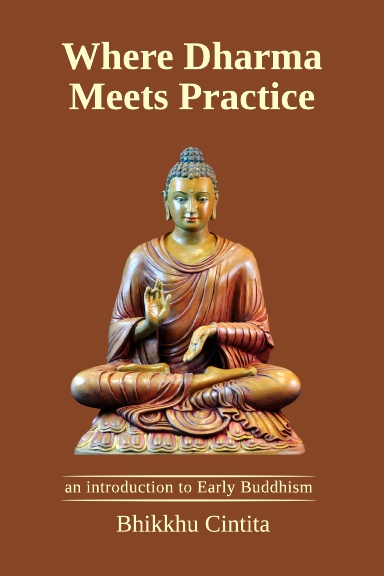
Bhikkhu Cintita, 2025, Where Dharma meets practice: and introduction to early Buddhism.
This is a very short, readable introduction to Dhamma that gives a lot of attention to experiential considerations in Dhamma practice, and to the expectations of modern people as they approach practice. It highlights right recollection (often translated as “mindfulness”) as the executive function in practice guided by Dhamma, where Dhamma meets practice.

| 
| Soon available from your favorite bookseller. |
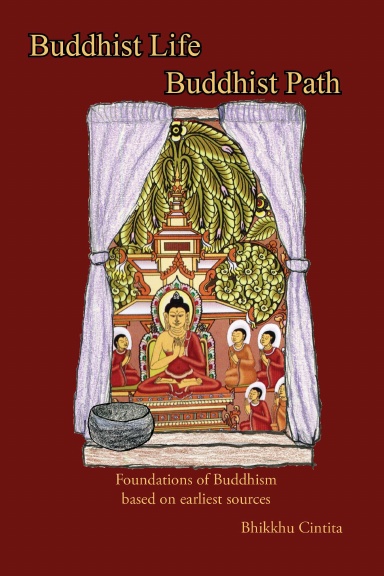
Bhikkhu Cintita, 2019, Buddhist Life/Buddhist Path: foundations of Buddhism based on earliest sources.
This is a thorough and comprehensive account early Dhamma, Vinaya and their practice. I’ve used in for teaching classes for many years, and I am about to (as of 10/2025) release a greatly updated edition. The second half focuses on the noble eightfold path, the first half on common practices that prepare one for taking full possession of the path.

| 
|
3. Early Buddhist Community
Buddhist communities have always had a diverse commitment to practice. Because its standards are so high, they require devout, wholehearted, 24/7, lifetime practice to fulfill. As a consequence, it cannot provide an easy answer, nor fit everyone into one size of practice. Nonetheless, although Buddhist practice often seems like an individual endeavor, and awakening an individual attainment, so do long lonely hours of practicing scales and chords, and virtuosity. Practice occurs in, and is meaningful in the context of community. The Buddha even equates the practice of the noble eightfold path with being under the influence of “admirable friends.” The results of awakening, or virtuosity are both certainly pro-social, a gift to the world.
The earliest members of the Buddhist community were wandering ascetics, as was the Buddha himself. The ones attracted to the Buddha’s teachings seem already to have been of exemplary commitment and wholeheartedness, for most of them seem to have attained the Buddha’s awakening in short order. The Buddha continued to teach primarily to ascetics throughout his career, even as hordes of enthusiastic householders joined his movement. From the ascetic community the Buddha established the Sangha, organizing them according to a special set of guidelines for monastic conduct, which he called the Vinaya (Discipline), a separate division of the Pali Canon from the Nikāyas. The Buddha called the whole body of his teachings Dhamma–Vinaya. Membership in he Sangha ensured an optimal social environment for those of high aspiration, strong practice, or advanced attainment, much as a university provides an apt environment for those of scholarly predilection. Astonishingly, the Saṅgha endures today virtually unchanged in virtually every Buddhist land, still following the Vinaya. (The use of the word Saṅgha to describe the whole Buddhist community seems to be of modern origin.)
In the Saṅgha we have evidence of the Buddha’s social thinking: it is highly decentralized, each local community makes decisions by consensus, and class distinctions are not recognized. Moreover, women are given status in the nuns’ Saṅgha, as equal to monks as could be managed in an otherwise highly patriarchal culture. Nuns seem to have awakened as readily as monks, and a number of nuns, alongside a few monks, were highly regarded as teachers, and their Dhamma talks are represented in the early discourses.
What did the Buddha think of women? (2012)
Buddhism is widely known throughout the world as a religion of peace and kindness. It is less known as a religion of gender-equality. This essay examines the status of Buddhist nuns at the time of the Buddha.
4. Reading the early Buddhist Texts
Depending on one’s level of commitment one may want to delve into the early Buddhist texts themselves. Reading these texts requires a lot of orientation, which my Buddhist Life/Buddhist Path, described above, will provide. The reason is that the early texts for the most part record fragmented Dhamma talks or sermons (suttas) of the Buddha which must be understood in terms of the whole body of other talks. Unfortunately, the Buddha never wrote a book that might have laid the Dhamma out systematically. The scope of Buddhist scriptures is huge, and it is only recently that scholars have been somewhat able to date then, and determine more or less which belong to the earliest stratum. The following seems to be the most authorative in determining the constitution of the early Buddhist texts:
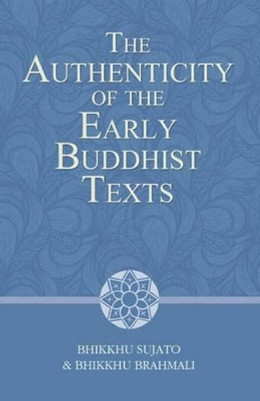
Ajahn Sujāto & Ajahn Brahmali, 2016, Authenticity of the Early Buddhist Texts, Buddhist Publication Society.
This appears to be the most authoritative statement to date of what are and are not early Buddhist texts. Significant are the first four of the five Nikāyas, early collections within the Pali Canon and isolated parts of the fifth, along with the corresponding parts of the Āgamas of the Chinese canon.
Although close in content, the Pali texts are much more accessible than the Chinese, because they are available in an early indic language rather than later sinitic translation, and they are now available entirely available in English translation. The site sutacentral.net collects early texts from many sources, translated into many languages in one place. The following are recommended renderings of the early texts translated from Pali into English.
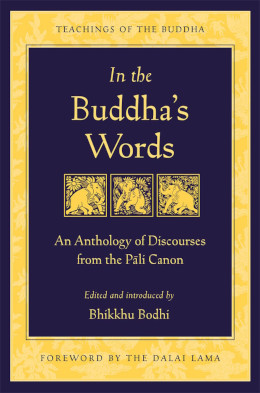
Bhikkhu Bodhi, 2005, In the Buddha’s Words: an anthology of discourses from the Pali Cannon, Wisdom Publications.
Bhikkhu Bodhi is an American monk, and the foremost living translator from Pali into English. He has collected here a large representative set of early suttas and passages from the Nikāyas, organized them by topic, and provided extensive commentary. I recommend to my students that they read this after Buddhist Life/Buddhist Path. It took over a year to read in Buddha’s Book Club.
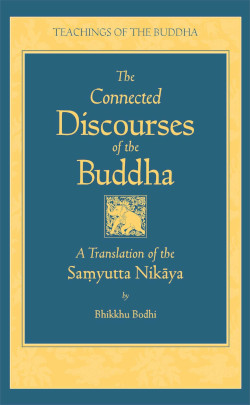
Bhikkhu Bodhi (trans), 2000, The Connected Discourses of the Buddha, Wisdom Publications
This and the other three volumes of Wisdom Publications’ discourses of the Buddha series (“Long Discourses,” “Middle Length Discourses,” and “Numbered Discourses“) represent the most popular English translations of the first four Nikāyas, two and a half of which are translated by the same Bhikkhu Bodhi. They are long, together occupying 10 1/2 inches on my shelf where I access them almost daily in my research.
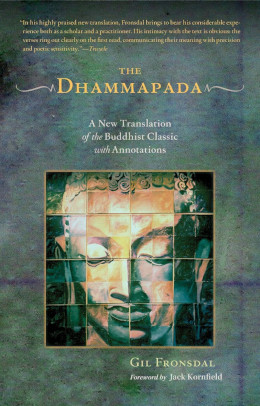
Gil Fransdal (trans.), 2005, The Dhammapada, Shambhala Publications.
This collection of aphorisms from the fifth Nikāya is perhaps the best known work in all of Buddhism. Readers find it inspiring at all levels of comprehension. It is short, and every Buddhist should read it. Although there are many translations in English, I recommend Gil Fronsdal’s.
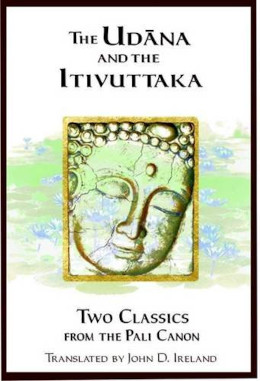
John D. Ireland (trans), 1998, The Udāna and the Itivuttaka: two classics from the Pali Canon, Buddhist Publication Society.
Like the Dhammapada, these are two early collections are from the fifth Nikāya. The Sutta Nipāta is a fourth.
5. An overview of study and practice
These are the topics covered in the pages under Study & Practice option on the menu bar.
You are on this page now.
The practice of ethics in early Buddhism centers around the acquisition of “virtue” in the development of human character on the path to awakening. Virtue includes such qualities as selflessness, kindness, compassion, etc., which become second-nature in order to promote harmless and beneficial prosocial behaviors most effectively. Ethical teaching are grounded psychologically in terms of purity of intentions. Although modern individualist culture rarely acknowledges it, we’ve all heard the expression, “Virtue is its own reward.”
In early Buddhism, wisdom is not an understanding of what is objectively true, but rather an understanding of what makes us think that certain things are true, for what we experience as true is never separate from mind. As a result, the wisdom teachings focus on the creative nature of human cognition constructing what we experience as real. Through wisdom we learn to experience the world in a more skillful way. We acquire wisdom through studying Dhamma, contemplating Dhamma in order to verify it in our own experience, then internalizing Dhamma with the help of composure so that it becomes second nature, the basis of our intuitive understanding of the world. The final result is “knowledge and vision of things as they really are.” Virtue and wisdom are not independent; the Buddha tells us that the purify each other.
Early Buddhist meditations are of two kinds: “Contemplations” attend to certain themes—such as kindness, suffering, or non-self—to be explored experientially. “Composure” (samādhi), the meditative states, is a faculty that fine-tunes other mental faculties to engage, and acquire mastery in a given practice most effectively. Composure is particularly, but not exclusively, important in combination with contemplation, and ultimately essential for the attainment of wisdom. Although practices that produce meditative states are almost always beneficial, the Buddha’s teachings on these states are widely misunderstood.
The Buddha understood practice as sustained by, and for the benefit of harmonious, selfless cooperation with others. This contrasts with the common modern view of Buddhist practice as primarily an individual endeavor. But then modern people tend to be unrepentant individualists. What’s more, progress on the path is fundamentally a process of acquiring pro-social qualities of virtue and wisdom, and awakening entails the perfection of those qualities. In the formation of the Sangha the Buddha established the social context most conducive to Dhamma practice.
Many faith and philosophical traditions posit an end goal or telos of practice. The telos in early Buddhism is the perfection of virtue and wisdom. However, its full attainment within this one life is relatively rare. However, the practice toward this end goal may be further pursued in subsequent lives. What is that about?
There is ongoing scholarly debate about the proper interpretation of many of the critical early Buddhist (particularly wisdom) teachings: What do they mean? How do we put them into practice? This page describes criteria for assessing potential interpretations employed in my published and posted works for deciding these issues.

